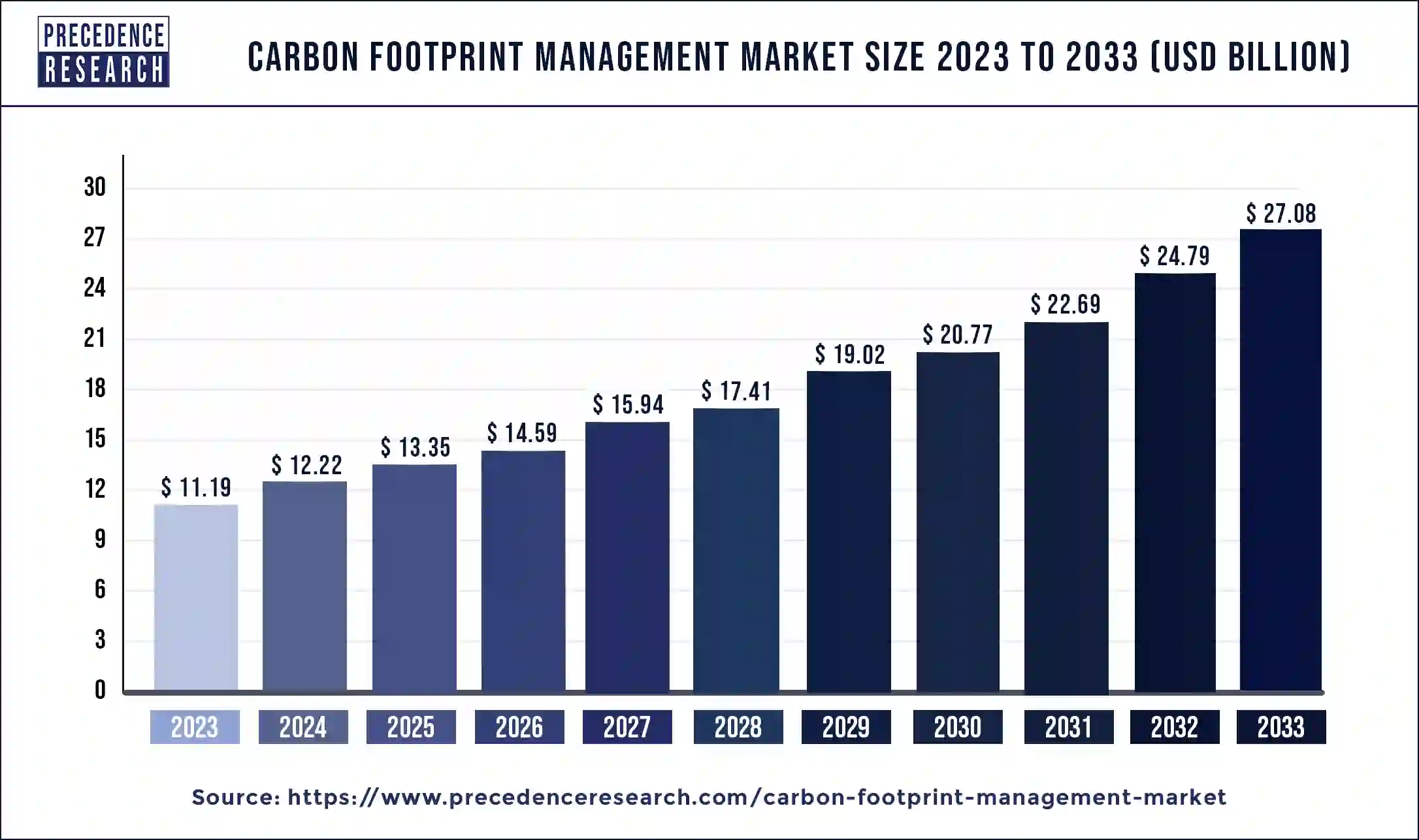The global carbon footprint management market size reached USD 11.19 billion in 2023 and is projected to hit around USD 27.08 billion by 2033, expanding at a CAGR of 9.24% from 2024 to 2033.
Key Points
- Asia Pacific led the market with the largest market share of 58% in 2023.
- North America is expected to grow in the market during the forecast period.
- By deployment, the cloud segment has contributed more than 57% of market share in 2023.
- By deployment, the on-premise segment is also growing in the market at a significant rate.
- By type, the enterprise tier segment has recorded over 41% of market share in 2023.
- By type, the mid-tier segment has generated more than 33% of market share in 2023.
- By end-use, the energy and utilities segment dominated the market with the biggest market share of 33% in 2023.
- By end-use, the manufacturing segment is expected to grow in the market during the forecast period.

The carbon footprint management market is witnessing substantial growth in response to escalating concerns regarding climate change and sustainability. Organizations across various sectors are increasingly recognizing the importance of measuring, monitoring, and mitigating their carbon emissions to minimize environmental impact and comply with regulatory requirements. Carbon footprint management solutions offer tools and technologies to help businesses assess their greenhouse gas emissions, identify areas for reduction, and implement strategies to achieve carbon neutrality. With the global focus on reducing carbon emissions and transitioning towards a low-carbon economy, the carbon footprint management market is poised for significant expansion in the coming years.
Get a Sample: https://www.precedenceresearch.com/sample/4045
Growth Factors
Several factors are driving the growth of the carbon footprint management market. Firstly, growing awareness of climate change and its adverse effects on the environment and human health has prompted governments, regulatory bodies, and international organizations to enact stringent regulations and initiatives to curb carbon emissions. As a result, businesses are under increasing pressure to measure and report their carbon footprint accurately and take measures to reduce emissions to comply with regulatory requirements and demonstrate environmental stewardship. Additionally, the rising adoption of corporate social responsibility (CSR) initiatives and sustainability goals among organizations, coupled with increasing investor and consumer scrutiny, is driving demand for carbon footprint management solutions. Moreover, advancements in technology, such as the Internet of Things (IoT), big data analytics, and artificial intelligence, are enabling more accurate and efficient carbon footprint measurement and management, further fueling market growth.
Region Insights
The carbon footprint management market exhibits regional variations in terms of adoption rates, regulatory frameworks, and market dynamics. Developed regions such as North America and Europe are at the forefront of carbon footprint management adoption, driven by stringent environmental regulations, government incentives, and a strong emphasis on sustainability. In North America, initiatives such as the Environmental Protection Agency’s (EPA) Greenhouse Gas Reporting Program and various state-level carbon pricing mechanisms have spurred demand for carbon footprint management solutions among businesses. Similarly, Europe has implemented ambitious targets for reducing greenhouse gas emissions under the European Green Deal, driving adoption of carbon footprint management solutions across industries. In contrast, emerging economies in Asia-Pacific and Latin America are witnessing growing awareness of carbon footprint management but face challenges related to regulatory enforcement and resource constraints.
Trends
Several trends are shaping the carbon footprint management market. One notable trend is the integration of carbon footprint management solutions with enterprise resource planning (ERP) systems and sustainability management platforms to streamline data collection, analysis, and reporting processes. This integration allows organizations to manage sustainability metrics alongside financial and operational data, facilitating more informed decision-making and comprehensive sustainability reporting. Another trend is the increasing demand for real-time carbon footprint monitoring and reporting capabilities, driven by the need for timely and transparent disclosure of emissions data to stakeholders. Additionally, there is a growing emphasis on supply chain sustainability and carbon footprint reduction among businesses, leading to the adoption of carbon footprint management solutions to assess and optimize supply chain emissions.
Carbon Footprint Management Market Scope
| Report Coverage | Details |
| Growth Rate from 2024 to 2033 | CAGR of 9.24% |
| Global Market Size in 2023 | USD 11.19 Billion |
| Global Market Size in 2024 | USD 12.22 Billion |
| Global Market Size by 2033 | USD 27.08 Billion |
| Largest Market | Asia Pacific |
| Base Year | 2023 |
| Forecast Period | 2024 to 2033 |
| Segments Covered | By Deployment, By Type, and By End-Use |
| Regions Covered | North America, Europe, Asia-Pacific, Latin America, and Middle East & Africa |
Carbon Footprint Management Market Dynamics
Drivers
Several drivers are driving the adoption of carbon footprint management solutions. Firstly, regulatory compliance is a significant driver, with governments worldwide implementing regulations and mandates to reduce carbon emissions and combat climate change. Organizations are compelled to invest in carbon footprint management solutions to comply with reporting requirements, avoid fines and penalties, and maintain a positive reputation among stakeholders. Moreover, corporate sustainability initiatives and commitments to reducing carbon emissions are driving demand for carbon footprint management solutions among businesses seeking to achieve carbon neutrality and demonstrate environmental leadership. Additionally, the potential cost savings associated with carbon footprint reduction, including energy efficiency improvements, waste reduction, and resource optimization, provide a strong incentive for organizations to invest in carbon footprint management solutions.
Opportunities
The carbon footprint management market presents numerous opportunities for vendors and service providers. With the increasing emphasis on sustainability and environmental responsibility, there is growing demand for comprehensive carbon footprint management solutions that offer robust measurement, reporting, and analysis capabilities. Vendors have the opportunity to differentiate themselves by offering innovative features such as predictive analytics, scenario modeling, and benchmarking to help organizations identify emission reduction opportunities and optimize sustainability initiatives. Moreover, as the market matures, there is potential for consolidation and partnerships among vendors to offer integrated sustainability and carbon management solutions that address the evolving needs of businesses across industries. Additionally, opportunities exist for consulting firms and sustainability experts to provide advisory services and support organizations in developing and implementing carbon reduction strategies.
Challenges
Despite the growth prospects, the carbon footprint management market faces several challenges. One of the primary challenges is the complexity of carbon footprint measurement and reporting, particularly for multinational corporations with diverse operations and supply chains. Ensuring consistency and accuracy in emissions data collection and reporting across geographies and business units can be challenging, requiring standardized methodologies and robust data management systems. Additionally, the lack of universal standards and guidelines for carbon footprint measurement and reporting poses challenges for organizations seeking to benchmark their performance and compare against industry peers. Moreover, limited awareness and understanding of carbon footprint management among small and medium-sized enterprises (SMEs) and resource constraints in emerging markets hinder market growth. Addressing these challenges will require collaborative efforts among governments, industry associations, and technology providers to promote awareness, develop standardized frameworks, and provide support to businesses in adopting carbon footprint management practices.
Read Also: pH Meter Market Size to Rise USD 1,581.92 Million by 2033
Recent Developments
- In May 2023, SAP launched a green ledger for businesses so that companies can manage to leave systems, carbon entering and balance carbon books, and tackle carbon footprint management challenges.
- In November 2022, the USE-based FRANEK sustainable management startup launched CarbonTek, a carbon footprint tool that manages the business’s measurement and analysis of carbon emissions.
Carbon Footprint Management Market Companies
- ProcessMAP
- Schneider Electric
- SAP
- Ecova
- Wolters Kluwer
- IBM Corporation
- Schneider Electric
- Dakota Software
- ENGINE
- IsoMetrix
Segments Covered in the Report
By Deployment
- On-Premise
- Cloud
By Type
- Basic Tier
- Mid-Tier
- Enterprise Tier
By End-Use
- Energy and Utilities
- Manufacturing
- Transportation
- IT and Telecommunication
- Residential and Commercial Buildings
By Geography
- North America
- Europe
- Asia-Pacific
- Latin America
- Middle East and Africa
Contact Us:
Mr. Alex
Sales Manager
Call: +1 9197 992 333
Email: sales@precedenceresearch.com
Web: https://www.precedenceresearch.com
Blog: https://www.expresswebwire.com/
Blog: https://www.uswebwire.com/
